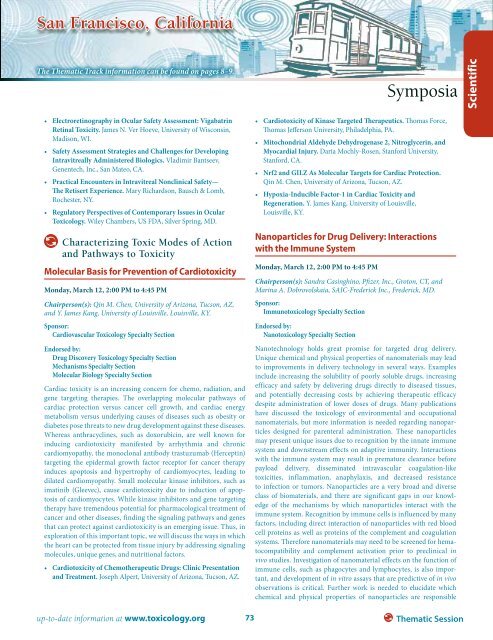51st Annual Meeting & ToxExpo - Society of Toxicology
51st Annual Meeting & ToxExpo - Society of Toxicology
51st Annual Meeting & ToxExpo - Society of Toxicology
Create successful ePaper yourself
Turn your PDF publications into a flip-book with our unique Google optimized e-Paper software.
San Francisco, California<br />
The Thematic Track information can be found on pages 8–9.<br />
• Electroretinography in Ocular Safety Assessment: Vigabatrin<br />
Retinal Toxicity. James N. Ver Hoeve, University <strong>of</strong> Wisconsin,<br />
Madison, WI.<br />
• Safety Assessment Strategies and Challenges for Developing<br />
Intravitreally Administered Biologics. Vladimir Bantseev,<br />
Genentech, Inc., San Mateo, CA.<br />
• Practical Encounters in Intravitreal Nonclinical Safety—<br />
The Retisert Experience. Mary Richardson, Bausch & Lomb,<br />
Rochester, NY.<br />
• Regulatory Perspectives <strong>of</strong> Contemporary Issues in Ocular<br />
<strong>Toxicology</strong>. Wiley Chambers, US FDA, Silver Spring, MD.<br />
Characterizing Toxic Modes <strong>of</strong> Action<br />
and Pathways to Toxicity<br />
Molecular Basis for Prevention <strong>of</strong> Cardiotoxicity<br />
Monday, March 12, 2:00 PM to 4:45 PM<br />
Chairperson(s): Qin M. Chen, University <strong>of</strong> Arizona, Tucson, AZ,<br />
and Y. James Kang, University <strong>of</strong> Louisville, Louisville, KY.<br />
Sponsor:<br />
Cardiovascular <strong>Toxicology</strong> Specialty Section<br />
Endorsed by:<br />
Drug Discovery <strong>Toxicology</strong> Specialty Section<br />
Mechanisms Specialty Section<br />
Molecular Biology Specialty Section<br />
Cardiac toxicity is an increasing concern for chemo, radiation, and<br />
gene targeting therapies. The overlapping molecular pathways <strong>of</strong><br />
cardiac protection versus cancer cell growth, and cardiac energy<br />
metabolism versus underlying causes <strong>of</strong> diseases such as obesity or<br />
diabetes pose threats to new drug development against these diseases.<br />
Whereas anthracyclines, such as doxorubicin, are well known for<br />
inducing cardiotoxicity manifested by arrhythmia and chronic<br />
cardiomyopathy, the monoclonal antibody trastuzumab (Herceptin)<br />
targeting the epidermal growth factor receptor for cancer therapy<br />
induces apoptosis and hypertrophy <strong>of</strong> cardiomyocytes, leading to<br />
dilated cardiomyopathy. Small molecular kinase inhibitors, such as<br />
imatinib (Gleevec), cause cardiotoxicity due to induction <strong>of</strong> apoptosis<br />
<strong>of</strong> cardiomyocytes. While kinase inhibitors and gene targeting<br />
therapy have tremendous potential for pharmacological treatment <strong>of</strong><br />
cancer and other diseases, finding the signaling pathways and genes<br />
that can protect against cardiotoxicity is an emerging issue. Thus, in<br />
exploration <strong>of</strong> this important topic, we will discuss the ways in which<br />
the heart can be protected from tissue injury by addressing signaling<br />
molecules, unique genes, and nutritional factors.<br />
• Cardiotoxicity <strong>of</strong> Chemotherapeutic Drugs: Clinic Presentation<br />
and Treatment. Joseph Alpert, University <strong>of</strong> Arizona, Tucson, AZ.<br />
Symposia<br />
• Cardiotoxicity <strong>of</strong> Kinase Targeted Therapeutics. Thomas Force,<br />
Thomas Jefferson University, Philadelphia, PA.<br />
• Mitochondrial Aldehyde Dehydrogenase 2, Nitroglycerin, and<br />
Myocardial Injury. Daria Mochly-Rosen, Stanford University,<br />
Stanford, CA.<br />
• Nrf2 and GILZ As Molecular Targets for Cardiac Protection.<br />
Qin M. Chen, University <strong>of</strong> Arizona, Tucson, AZ.<br />
• Hypoxia-Inducible Factor-1 in Cardiac Toxicity and<br />
Regeneration. Y. James Kang, University <strong>of</strong> Louisville,<br />
Louisville, KY.<br />
Nanoparticles for Drug Delivery: Interactions<br />
with the Immune System<br />
Monday, March 12, 2:00 PM to 4:45 PM<br />
Chairperson(s): Sandra Casinghino, Pfizer, Inc., Groton, CT, and<br />
Marina A. Dobrovolskaia, SAIC-Frederick Inc., Frederick, MD.<br />
Sponsor:<br />
Immunotoxicology Specialty Section<br />
Endorsed by:<br />
Nanotoxicology Specialty Section<br />
Nanotechnology holds great promise for targeted drug delivery.<br />
Unique chemical and physical properties <strong>of</strong> nanomaterials may lead<br />
to improvements in delivery technology in several ways. Examples<br />
include increasing the solubility <strong>of</strong> poorly soluble drugs, increasing<br />
efficacy and safety by delivering drugs directly to diseased tissues,<br />
and potentially decreasing costs by achieving therapeutic efficacy<br />
despite administration <strong>of</strong> lower doses <strong>of</strong> drugs. Many publications<br />
have discussed the toxicology <strong>of</strong> environmental and occupational<br />
nanomaterials, but more information is needed regarding nanoparticles<br />
designed for parenteral administration. These nanoparticles<br />
may present unique issues due to recognition by the innate immune<br />
system and downstream effects on adaptive immunity. Interactions<br />
with the immune system may result in premature clearance before<br />
payload delivery, disseminated intravascular coagulation-like<br />
toxicities, inflammation, anaphylaxis, and decreased resistance<br />
to infection or tumors. Nanoparticles are a very broad and diverse<br />
class <strong>of</strong> biomaterials, and there are significant gaps in our knowledge<br />
<strong>of</strong> the mechanisms by which nanoparticles interact with the<br />
immune system. Recognition by immune cells is influenced by many<br />
factors, including direct interaction <strong>of</strong> nanoparticles with red blood<br />
cell proteins as well as proteins <strong>of</strong> the complement and coagulation<br />
systems. Therefore nanomaterials may need to be screened for hematocompatibility<br />
and complement activation prior to preclinical in<br />
vivo studies. Investigation <strong>of</strong> nanomaterial effects on the function <strong>of</strong><br />
immune cells, such as phagocytes and lymphocytes, is also important,<br />
and development <strong>of</strong> in vitro assays that are predictive <strong>of</strong> in vivo<br />
observations is critical. Further work is needed to elucidate which<br />
chemical and physical properties <strong>of</strong> nanoparticles are responsible<br />
Scientific<br />
up-to-date information at www.toxicology.org 73<br />
Thematic Session
















